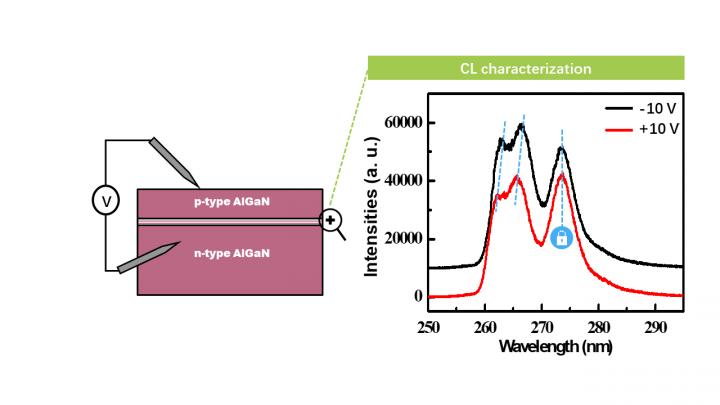
Credit: by Li Chen, Wei Lin, Huiqiong Wang, Jinchai Li, Junyong Kang
Deep ultraviolet (DUV) optoelectronic devices (
To understand the underlying mechanism of orbital intercoupling based on the quantum con?nement direction, high-Al-content AlGaN QW models were constructed and studied by first-principle simulations. The band structure analysis shows that valence band is consist of p orbitals. p orbitals overlapping in a head-over-head fashion tend to form ppσ coupling with positive energy gain, while p orbital overlapping with one another in a side-by-side fashion tend to bring about ppπ coupling with negative energy variation. In the c-plane polar AlGaN QW, the compensation of CH band potential barrier at VBM is dominantly contributed from the ppσ coupling. In the case of the HH/LH band, the barrier is enhanced by the ppπ coupling. The carrier distribution and the orbital projected density of states at VBM along the confinement direction in figure 2 exhibit that the dominant ppσ coupling of pz state lower the potential barrier, resulting in the delocalization of the pz orbital. The situation is reversed upon the the ppπ coupling that px orbital have higher barrier for quantum confinement to confine carriers in the quantum well.
In the light of the relationship between the orbital coupling and the confinement direction, orbital engineering was proposed by incline quantum well plane to modify the energy variations in duced by the orbital coupling. Al0.75Ga0.25N/AlN quantum well models were constructed with the well plane inclined from 0° to 90° at a step of 30° referred to the c plane. The inclination angle of 30° and 60° correspond to the (10¯13) and (10¯11), two 90° models of (10¯10) and (11¯20) plane nonpolar quantum well. As increasing the inclination angles, the ppσ component decreases while the ppπ component increases. The distribution of p states at VBM further confirm the enhancement of quantum confinement with the increase in radiative transition rate at the band edge. Experimentally, the quantum well were grown on different facets of the hexagonal microrods with pyramid-shaped tops , as shown in figure 3. According to scanning electron microscope and cathodoluminescence (CL) spectra, even the characterization are taken from the top of the pyramid, the emission from the quantum well on the nonpolar plane is stronger than that on the semipolar and polar plane, which demonstrates the feasibility of the orbital engineering.
The research effort in the present work has led to the evidence that the orbital intercoupling plays a pivotal role especially in the materials with strong polarization. The valence p orbitals in the quantum structure are sensitive to the confinement direction, which distorts the symmetric the rectangular well potential. Awareness of the orbital intercoupling and its influence on the well potential provides a new perspective on the construction of heterostructures and superlattices. It has been reported in the literature that high-temperature superconductivity is observed in charge-transfer compounds characterized by strong hybridization between oxygen 2p and transition metal 3d states and with complex electronic configurations, which gives hints for the active presence of the orbital coupling. It is natural to expect that the orbital engineering is not just limited to AlGaN but also to extending the applications in novel semiconductor material and structure with unique functional properties.
###
Media Contact
Wei Lin
[email protected]
Related Journal Article
http://dx.




